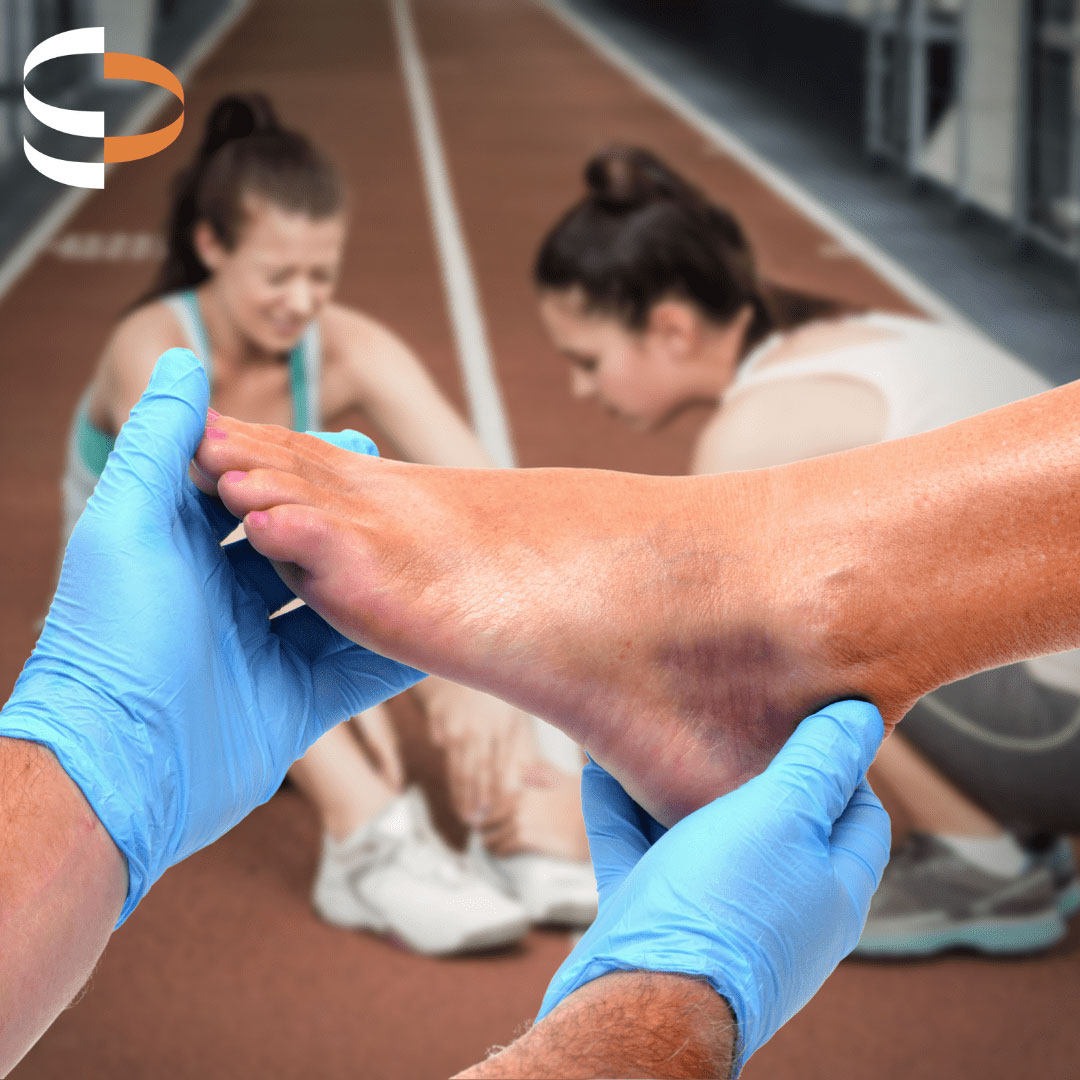WE HAVE ALL BEEN THERE! Slipped, tripped or lost balance while at home, out walking or being active. It is surprisingly easy to lose your footing and sprain your ankle. DO NOT PANIC! We are here to help manage your ankle pain, and guide your ankle sprain rehab!
Acute, lateral ankle sprains & injuries are extremely common. You may think it was just bad luck, however, having poor balance, proprioception, and muscular control/strength are potential contributing factors to your ankle joint injury.
Here you’ll learn what to do immediately, be able to use a couple of handy ankle exercises, and know when to seek sprained ankle treatment.
WHAT HAS HAPPENED?
A momentary jerk to the side while transferring weight between legs while moving is the most common mechanism. A twinge pain is felt, usually on the outside of the ankle (lateral malleolus), and swelling sometimes follows.
What have I damaged? Most often it’s the ankle ligaments that are partially torn, especially when swelling is visible. On rare occasions the ligament remains intact and pulls at the bone causing a fracture at the attachment site, however, this often requires a greater force. If the bone is particularly tender, or you’re having inner ankle pain, or even pain through the foot (potentially a sprained foot) then a trip to your health professional may help with further diagnosis.
Along with ligament injury, your tendons may have also been strained and the joint surface also injured or irritated.
IMMEDIATE ANKLE MANAGEMENT
First and most obvious management step is to stop walking around and recognize that you have an injury. It is unlikely you will be able to walk this one off.
Then apply some PEACE & LOVE!!!! The latest version of RICE (Rest, Ice, Compress, Elevate).
P – Protect: avoid any activity that increases pain.
E – Elevate: gravity will help reduce any swelling to the area that may also increase pain.
A – Avoid anti-inflammatories: this medication within initial 48 hours may disrupt the normal healing process.
C – Compress: a compression bandage or tape applied correctly can reduce pain and aid healing
E – Education: seek physiotherapist advice on the scope and further management of the injury.
L – Load: let pain guide your return to activity post injury. If it hurts you may not be ready.
O – Optimism: if managed appropriately this injury will improve with time and you’ll be back to your normal daily activities
V – Vascularisation: regular cardiovascular movement (walking) and activity that is pain free will help with recovery.
E – Exercise: strength, balance, and proprioception (joint / body awareness) are vital to return to prior activity and to ensure further injury risk is also reduced.
WHERE DO I GO FROM HERE?
Two situations may be occurring. You have been successful with immediate injury management, or you have not.
1. The immediate injury seems to have improved. You have no pain or swelling and the bruising should have disappeared, and you are able to do most activities like walking and running pain free.
Fantastic work, your job does not end here however. As mentioned in PEACE AND LOVE, you need to continue your management at the injury site to prevent further injury.
Whenever an injury occurs in the body, something has been damaged or altered. For example, there may be a reduction in strength, balance, proprioception (joint awareness) or muscle – brain communication. If these deficits are not improved, then the risk of re-injury and typically a more severe injury may occur.
The body is good at healing itself, however unlike lizards, we do not grow back the damaged areas quite so well.
2. The immediate injury has not improved, and your pain, swelling and movement are unchanged. This is the time to seek medical advice immediately. There is no need to panic! It’s unlikely with an ankle sprain that your life is at risk, and you may just need to modify your initial management just slightly. However, you do not want to leave a non-improving injury too long before seeking advice.
Helpful Exercises
A good starting point for your rehabilitation is gentle joint range of motion, within a pain-free area. So, with reduction in swelling and pain, start moving the ankle forward – backward – sideways, as frequently through the day as you remember to. The only limiting factor would be if after you have gone through all the directions that you have an increase in your pain or swelling.
Strength is the next starting point and gentle resisted movement of the above directions will be a good starting point. So push into the ground or your other foot. Once walking has normalised greater resistance with bands, and calf raises can begin.
Balance is a must! Your stability has likely been affected and you will need to practice both dynamic (moving – e.g. heel to toe walking) and static (stand still – e.g. one leg) balance drills. Take care not to re-injure yourself during this training by providing nearby support.
Impacting is the final step including drills like jumping, hopping and skipping. You may then progress to changing the angle of movement to include forward, backward, sideward and diagonals. It is safe to begin impacting when strength from the injured ankle / limb is becoming closer to the non-injured limb and balance has improved.
The final exercise is running, which is impacting at speed. This should be done in a staged manner with regular walking to break up the run distances until continuous running is tolerated.
TAKE HOME MESSAGE
Ankle sprains are a common injury! However, they should not be ignored and rehabilitation is important to reduce further injury. The initial PEACE and LOVE approach should help to reduce pain and swelling, we don’t only use ice packs for rolled ankles anymore! Ice may be good for pain relief, however will not always alter the duration of injury management.
Regardless of home management, a health professional like the team at Leaders Physiotherapy in the Brisbane CBD are well equipped to help guide you through the rehabilitation process to make sure you are properly educated about your injury and what to expect in the future. They also provide and fit ankle braces, and have extensive knowledge around ankle rehabilitation for the weekend warrior to the elite athlete.






